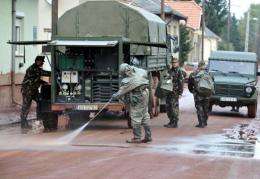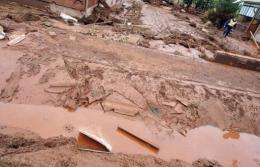Toxic mud spill kills four in Hungary

Hungary declared a state of emergency on Tuesday after a toxic mud spill killed four people and injured 120 in what officials described as Hungary's worst-ever chemical accident.
With eight people in serious condition and as many as six people missing, officials fear the death toll could rise after the walls of a reservoir of residue at an aluminium plant in Ajka, 165 kilometres (102 miles) west of Budapest, broke on Monday afternoon.
Three nearby villages were swamped with 1.1 million cubic metres (38.8 million cubic feet) of toxic red sludge, leading the interior ministry to call a state of emergency in the counties of Veszprem, Gyor-Moson-Sopron and Vas on Tuesday.
According to Karoly Tily, the mayor of Kolontar, one of the villages, two children -- aged three and one -- were among the dead.
A 25-year-old man was killed when his car was overturned by the flood and an elderly man died in his home, the disaster relief team said.
Among the injured were eight policemen, eight firefighters and a soldier and 62 people were hospitalised.
"It's an ecological catastrophe," said environment state secretary Zoltan Illes, who visited the area Tuesday, describing its as the worst-ever chemical accident in Hungary.
Up to 40 square kilometres (15.4 square miles) of land were affected and there were fears that some of the sludge had already found its way into the Marcal river and could therefore potentially pollute the connecting Raba and Danube rivers.
In a bid to prevent that, army helicopters had dropped neutralising agents into the Marcal, Illes said.
"It must be collected and neutralised so as to prevent a full ecological catastrophe affecting the entire region," Illes said.
The red mud is a toxic residue left over from aluminium production and contains harmful substances such as lead as well as highly corrosive elements.
The production of a tonne of aluminium generates nearly three tonnes of the sludge.

According to the Hungarian news agency MTI, the Western Transdanubian Environmental Protection and Water Management authority has issued a high alert along the Marcal river and the adjoining Torna, which will remain in place until Wednesday.
The owners of the reservoir, the Hungarian Aluminium Production and Trade Company (MAL), said it had started repair work on the damaged tanks to prevent further spills.
In a statement, MAL said that even after the spill, up to 98 percent of the red sludge was still in the reservoir.
An on-site inspection had been carried out on the day of the accident "and the latest analysis of the water sample taken at the slurry wall revealed no signs of an impeding catastrophe," the company said.
It insisted that, under European Union guidelines, red sludge is not considered hazardous waste and its components are not water-soluble.
(c) 2010 AFP















